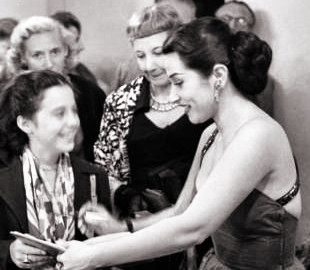YMA (EE-mah)
Peruvian
recording artist
Common clues: Singer
Sumac; Vocalist Sumac; Peruvian singer Sumac; Diva Sumac; Sumac
with a five-octave range; 1950s singer Sumac; Nonpoisonous
Sumac?
Crossword
puzzle frequency:
4 times a year
Video: Chuncho
Well, in the 50's I went to Italy and a very important critic said to me, "Madame Sumac, with all due respect, here in Italy we have the greatest singers in the world. So do not expect the same kind of reviews you received everywhere else in the world." I raised one eyebrow, but said nothing. That night, I did 'The Magical Flute' and my voice was the flute! I got a standing ovation for over 20 minutes! Afterwards the critic did not come to my dressing room to visit...he left! – Yma Sumac
Yma Sumac (September 13, 1922 – November 1, 2008) was a noted Peruvian soprano. In the 1950s, she was one of the most famous proponents of exotica music and became an international success, based on the merits of her extreme vocal range, which was said to be "well over four octaves" and was sometimes claimed to span even five octaves at her peak.
Yma Sumac recorded an extraordinarily wide vocal range of slightly over five octaves from B2 to C#7 (approximately 123 to 2270 Hz). She was able to sing notes in the low baritone register as well as notes above the range of an ordinary soprano. Both low and high extremes can be heard in the song Chuncho (The Forest Creatures) (1953). She was also apparently able to sing in an eerie "double voice".

Zoila Augusta Emperatriz Chávarri del Castillo was born on September 10, 1922, in Ichocán, Cajamarca, Peru. While one of her "official" websites says that the "official date" of her birth is September 10, the date on a different "official" website is given as September 13, 1922 (according to her personal assistant, who claimed to have seen her birth certificate). Other dates mentioned in her various biographies range from 1921 to 1929. Some sources claim that she was not born in Ichocán, but in a nearby village, or possibly in Lima, and that her family owned a ranch in Ichocán where she spent most of her early life.
Stories published in the 1950s claimed that she was an Incan princess, directly descended from Atahualpa. Her New York Times obituary reported that, "The largest and most persistent fabrication about Ms. Sumac was that she was actually a housewife from Brooklyn named Amy Camus, her name spelled backward. The fact is that the government of Peru in 1946 formally supported her claim to be descended from Atahualpa, the last Incan emperor."
Chávarri adopted the stage name of Imma Sumack (also spelled Ymma Sumack and Ima Sumack) before she left South America to go to the U.S. The stage name was based on her mother's name, which was derived from Ima Shumaq, Quechua for "how beautiful!" although in interviews she claimed it meant "beautiful flower" or "beautiful girl".
Imma Sumack first appeared on radio in 1942 and married composer and bandleader, Moisés Vivanco, on June 6 of the same year. She recorded at least eighteen tracks of Peruvian folk songs in Argentina in 1943. These early recordings for the Odeon label featured Moisés Vivanco's group, Compañía Peruana de Arte, a group of forty-six Indian dancers, singers, and musicians.
In 1946, Sumack and Vivanco moved to New York City, where they performed as the Inka Taky Trio, Sumack singing soprano, Vivanco on guitar, and her cousin Cholita Rivero singing contralto and dancing. Sumack bore a son, Charles, in 1949, and was signed by Capitol Records in 1950, at which time her stage name became Yma Sumac.
During the 1950s, Yma Sumac produced a series of legendary lounge music recordings featuring Hollywood-style versions of Incan and South American folk songs, working with the likes of Les Baxter and Billy May. The combination of her extraordinary voice, exotic looks, and stage personality made her a hit with American audiences. Sumac appeared in a Broadway musical, Flahooley, in 1951, as a foreign princess who brings Aladdin's lamp to an American toy factory to have it repaired. The show's score was by Sammy Fain and E. Y. "Yip" Harburg, but Sumac's three numbers were the work of Vivanco with one co-written by Vivanco and Fain.
Capitol Records, Sumac's label, recorded the show. Flahooley closed quickly, but the recording continues as a cult classic, in part because it also marked the Broadway debut of Barbara Cook. During the height of Sumac's popularity, she appeared in the films Secret of the Incas (1954) and Omar Khayyam (1957). She became a U.S. citizen on July 22, 1955. In 1959, she popularized Jorge Bravo de Rueda's classic song "Vírgenes del Sol" on her Fuego del Ande long playing album (LP).
In 1957, Sumac and Vivanco divorced, their dispute making news in Los Angeles. They remarried that same year, but divorced again in 1965.
Apparently due to financial difficulties, Yma Sumac and the original Inka Taky Trio went on a world tour in 1961, which lasted for five years. They performed in forty cities in the Soviet Union, and afterward throughout Europe, Asia, and Latin America. Their performance in Bucharest, Romania, was recorded as the album Recital, her only 'live in concert' record. Yma Sumac spent the rest of the 1960s performing sporadically.
Yma Sumac died on November 1, 2008, aged 86 at an assisted-living home in Los Angeles, nine months after being diagnosed as having colon cancer. She was interred at the Hollywood Forever Cemetery in Hollywood, California in the "Sanctuary of Memories" section.
This article is licensed under the GNU Free Documentation License. It uses material from the Wikipedia article "Yma Sumac".
|
|